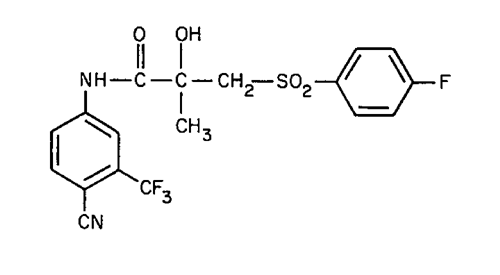Bicalutamide
Propanamide,N-[4-cyano-3-(trifluoromethyl)phenyl]-3-[(4-fluo-rophenyl)sulfonyl]-2-hydroxy-2-methyl-, (±)-.
(±)-4¢-Cyano-
» Bicalutamide contains not less than 98.0 percent and not more than 102.0 percent of C18H14F4N2O4S, calculated on the anhydrous and solvent-free basis.
Packaging and storage—
Preserve in tight containers, and store at room temperature.
Identification
B:
The retention time of the major peak in the chromatogram of the Assay preparation corresponds to that in the chromatogram of the Standard preparation, as obtained in the Assay.
Water, Method I  921
921 :
not more than 0.2%.
:
not more than 0.2%.
Residue on ignition  281
281 :
not more than 0.1%.
:
not more than 0.1%.
Heavy metals, Method II  231
231 :
0.001%.
:
0.001%.
Related compounds—
Mobile phase—
Proceed as directed in the Assay.
Standard solution—
Dissolve an accurately weighed quantity of USP Bicalutamide RS in a minimum amount of tetrahydrofuran, and dilute quantitatively with Mobile phase to obtain a solution having a known concentration of about 0.02 mg per mL.
System suitability solution—
Dissolve an accurately weighed quantity of USP Bicalutamide RS and USP Bicalutamide Related Compound B RS in a minimum amount of tetrahydrofuran, and dilute quantitatively with Mobile phase to obtain a solution having known concentrations of about 0.05 mg per mL of bicalutamide and 0.02 mg per mL of bicalutamide related compound B, respectively.
Test solution—
Dissolve an accurately weighed quantity of Bicalutamide in a minimum amount of tetrahydrofuran, and dilute quantitatively with Mobile phase to obtain a solution having a known concentration of about 4.0 mg per mL.
Chromatographic system (see Chromatography  621
621 )—
Prepare as directed in the Assay. Chromatograph the System suitability solution, and record the peak responses as directed for Procedure: the resolution, R, between bicalutamide and bicalutamide related compound B is not less than 2.0; the tailing factor for the bicalutamide peak is less than 1.3; and the relative standard deviation of the bicalutamide peak for replicate injections is not more than 4%.
)—
Prepare as directed in the Assay. Chromatograph the System suitability solution, and record the peak responses as directed for Procedure: the resolution, R, between bicalutamide and bicalutamide related compound B is not less than 2.0; the tailing factor for the bicalutamide peak is less than 1.3; and the relative standard deviation of the bicalutamide peak for replicate injections is not more than 4%.
Procedure—
Separately inject equal volumes (about 10 µL) of the Standard solution and the Test solution into the chromatograph, and record the chromatograms. Calculate the percentage of each impurity in the portion of Bicalutamide taken by the formula:
100(CS / CU)(ri / rS)
in which CS and CU are the concentrations, in mg per mL, of bicalutamide in the Standard solution and the Test solution, respectively; ri is the peak response for each impurity obtained from the Test solution; and rS is the peak response for bicalutamide obtained from the Standard solution. The limits are given in Table 1.
Table 1
| Name | RRT | Limit (%) | |
| Des-fluoro analog1 | 0.74 | 0.2 | |
| 2-Fluoro isomer2 | 0.78 | 0.2 | |
| Des hydroxy analog3 | 1.19 | 0.2 | |
| Individual unspecified impurity | — | 0.1 | |
| Total unspecified impurities | — | 0.3 | |
| Total impurities | — | 0.5 | |
|
1
(RS)-4¢-Cyano-3-phenylsulfonyl-2-hydroxy-2-methyl-3¢-(trifluoromethyl)propionanilide.
|
|||
|
2
(RS)-4¢-Cyano-3-(2-fluorophenylsulfonyl)-2-hydroxy-2-methyl-3¢-(trifluoromethyl)-propionanilide.
|
|||
|
3
(RS)-4¢-Cyano-3-(4-fluorophenylsulfonyl)-2-methyl-3¢-(trifluoromethyl)propionanilide.
|
|||
Assay—
Mobile phase—
Prepare a mixture of water, methanol, and tetrahydrofuran (55:30:15).
Standard preparation—
Dissolve an accurately weighed quantity of USP Bicalutamide RS in a minimum amount of tetrahydrofuran, and dilute quantitatively with Mobile phase to obtain a solution having a known concentration of about 0.05 mg per mL.
Assay preparation—
Dissolve an accurately weighed quantity of Bicalutamide in a minimum amount of tetrahydrofuran, and dilute quantitatively with Mobile phase to obtain a solution having a known concentration of about 0.05 mg per mL.
Chromatographic system (see Chromatography  621
621 )—
The liquid chromatograph is equipped with a 270-nm detector and a 5-mm × 25-cm column that contains 5-µm packing L1. The flow rate is about 1.8 mL per minute. The column temperature is maintained at 35
)—
The liquid chromatograph is equipped with a 270-nm detector and a 5-mm × 25-cm column that contains 5-µm packing L1. The flow rate is about 1.8 mL per minute. The column temperature is maintained at 35 to 40
to 40 . Chromatograph the Standard preparation, and record the peak responses as directed for Procedure: the relative standard deviation for replicate injections is not more than 2%.
. Chromatograph the Standard preparation, and record the peak responses as directed for Procedure: the relative standard deviation for replicate injections is not more than 2%.
Procedure—
Separately inject equal volumes (about 10 µL) of the Standard preparation and the Assay preparation into the chromatograph, record the chromatograms, and measure the responses for the major peaks. Calculate the quantity, in percent, of C18H14F4N2O4S in the portion of Bicalutamide taken by the formula:
100(CS / CU)(rU / rS)
in which CS is the concentration, in mg per mL, of USP Bicalutamide RS in the Standard preparation; CU is the concentration of Bicalutamide, in mg per mL, in the Assay preparation; and rU and rS are the peak responses obtained from the Assay preparation and the Standard preparation, respectively.
Auxiliary Information—
Please check for your question in the FAQs before contacting USP.
Chromatographic Column—
| Topic/Question | Contact | Expert Committee |
| Monograph | Feiwen Mao, M.S.
Scientist 1-301-816-8320 |
(MDOOD05) Monograph Development-Ophthalmics Oncologics and Dermatologicals |
| Reference Standards | Lili Wang, Technical Services Scientist 1-301-816-8129 RSTech@usp.org |
USP32–NF27 Page 1673
Pharmacopeial Forum: Volume No. 33(5) Page 876
Chromatographic columns text is not derived from, and not part of, USP 32 or NF 27.

